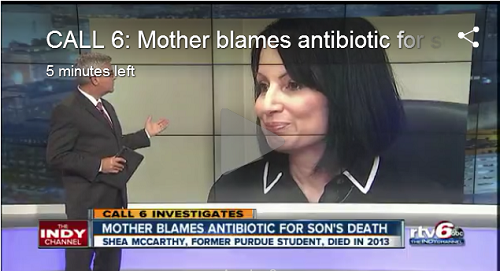Please read and share post, “Psychiatric Adverse Reactions to Pharmaceuticals Ignored” that was published on Hormones Matter. It highlights the tragic story of Shea McCarthy, a young man who lost his life after suffering from a severe psychiatric adverse reaction to Levaquin.
The severe psychiatric adverse reactions to fluoroquinolones need to be recognized and acknowledged. No one is choosing to have a severe psychiatric adverse reaction to a drug, yet people with psychiatric adverse reactions are often ignored and disregarded. As you can see from Shea’s tragic story, not listening to people who have psychiatric adverse reactions to drugs can have tragic consequences.
Here is the video of the news story, “CALL 6: Mother blames antibiotic for son’s death – Purdue University student took Levaquin:”
There are several possible mechanisms through which fluoroquinolones can cause anxiety, depression, insomnia, psychosis, and other severe psychiatric adverse-effects. Oxidative stress may be the mechanism through which fluoroquinolones cause severe psychiatric problems, as I described in “Can Antibiotics Induce Psychiatric Reactions?” Maybe gut microbiome destruction by fluoroquinolones leads to the psychiatric adverse effects. The Psychology Today article, “The Gut-Brain Connection, Mental Illness, and Disease” goes over evidence that our gut microbiome is intricately linked to our mental health. Obviously, fluoroquinolones are powerful antibiotics that destroy the gut microbiome. Another possibility, one that I have not previously explored, is that fluoroquinolones cause severe psychiatric reactions because they have a piperazine attachment to the quinolone core. In the picture below, the quinolone core is zone 4 and the piperazine attachment is zone 3.

Ciprofloxacin is 1-cyclopropyl-6-fluoro-1,4-dihydro-4-oxo-7-(1-piperazinyl)-3-quinolinecarboxylic acid.
Piperazine blocks GABA activity. GABA is gamma-Aminobutyric acid, “the chief inhibitory neurotransmitter in the mammalian central nervous system. It plays the principal role in reducing neuronal excitability throughout the nervous system. In humans, GABA is also directly responsible for the regulation of muscle tone.” (wiki) When GABA is blocked, people feel edgy, agitated, excited (not in a good way), anxious, and can suffer from insomnia, muscle spasms, seizures, and more.
Piperazine is often used “for making fake ecstasy because of the similarity in taste, and at certain doses, a user may experience favorable side effects and feel ‘high.’” (source) It is also often mixed with MDMA in ecstasy.
Additionally, it is noted in “Acetylcholine (ACh) – Related Damage” on http://fluoroquinolonethyroid.com/ that:
“Piperazines (anti-parasiticals which kill parasites by paralyzing them) have neuromuscular effects which are thought to be caused by blocking acetylcholine at the myoneural junction. (Plenty of pets have been poisoned with over the counter piperazine toxicity from wormers – so no, it’s not just helminths they affect). Among the numerous properties of Piperazine derivatives, they are not only muscarinic antagonists, but also are the basis for recreational drugs with euphoria and stimulant properties, such as amphetamines, BZP, MDMA [rather, ecstasy, as noted above], and TFMPP, along with all the negative side effects of these drugs (no wonder I was hallucinating during my acute reaction). So now we have a toxic neuromuscular agent with amphetamine/ecstasy-like effects (piperazine), along with a toxic iodine displacer (fluorine), attached to a chemotherapeutic agent with an intracellular, intranuclear, and intra-mitochondrial genotoxic mechanism of action (quinolone) – a synthetic, fluoridated, neurotoxic, genotoxic chemotherapeutic poison masquerading as an antibiotic and being given en masse to the human and animal population.”
Fluoroquinolones “are known to non-competitively inhibit the activity of the neurotransmitter, GABA, thus decreasing the activation threshold needed for that neuron to generate an impulse.” (source, source, source) Fluoroquinolones have also been shown to have similar effects on GABA neurotransmitters as benzodiazepine withdrawal (source).
The inhibition of GABA by the piperazine part of fluoroquinolones is a plausible, even likely, mechanism for the many horrible psychiatric effects that people suffer from after taking fluoroquinolones.
In a survey of 94 people who experienced adverse reactions to Levaquin/levofloxacin, a fluoroquinolone antibiotic, 72% reported experiencing anxiety, 62% reported depression, 48% reported insomnia, 37% reported panic attacks, 33% reported brain fog and/or cognitive impairment, 29% reported depersonalization and/or derealization, 24% reported thoughts of suicide and 22% reported psychosis. (source, source)
More than 20 million prescriptions for fluoroquinolones are given out in the U.S. each year. If even only 1% of the people who take fluoroquinolones experience a psychiatric adverse-reaction, that’s still a lot of people whose minds aren’t their own, who are suffering from depression, anxiety, insomnia and worse, because of an antibiotic that is made with a chemical that has amphetamine/ecstasy-like effects.
These effects can have tragic consequences, as can be seen in the video and article mentioned above about Shea McCarthy.
Psychiatric adverse effects of prescription drugs are serious, and they should be taken seriously. They are not a choice. No one would choose to feel psychotic, or even anxious.
There are many plausible mechanisms through which fluoroquinolones can cause psychiatric problems. Perhaps it is time that the psychiatric effects of fluoroquinolones become more widely recognized.












… [Trackback]
[…] Find More on that Topic: floxiehope.com/serious-psychiatric-reactions-from-fluoroquinolones/ […]
… [Trackback]
[…] There you can find 24748 more Information to that Topic: floxiehope.com/serious-psychiatric-reactions-from-fluoroquinolones/ […]
… [Trackback]
[…] Here you can find 77633 additional Info on that Topic: floxiehope.com/serious-psychiatric-reactions-from-fluoroquinolones/ […]
… [Trackback]
[…] Here you will find 60692 additional Information on that Topic: floxiehope.com/serious-psychiatric-reactions-from-fluoroquinolones/ […]
… [Trackback]
[…] Find More Information here to that Topic: floxiehope.com/serious-psychiatric-reactions-from-fluoroquinolones/ […]
… [Trackback]
[…] Find More here to that Topic: floxiehope.com/serious-psychiatric-reactions-from-fluoroquinolones/ […]
… [Trackback]
[…] Read More to that Topic: floxiehope.com/serious-psychiatric-reactions-from-fluoroquinolones/ […]
… [Trackback]
[…] Information to that Topic: floxiehope.com/serious-psychiatric-reactions-from-fluoroquinolones/ […]
… [Trackback]
[…] Read More Info here on that Topic: floxiehope.com/serious-psychiatric-reactions-from-fluoroquinolones/ […]
… [Trackback]
[…] Read More on to that Topic: floxiehope.com/serious-psychiatric-reactions-from-fluoroquinolones/ […]
… [Trackback]
[…] Info to that Topic: floxiehope.com/serious-psychiatric-reactions-from-fluoroquinolones/ […]
… [Trackback]
[…] Find More on on that Topic: floxiehope.com/serious-psychiatric-reactions-from-fluoroquinolones/ […]
… [Trackback]
[…] Find More to that Topic: floxiehope.com/serious-psychiatric-reactions-from-fluoroquinolones/ […]
… [Trackback]
[…] Find More Information here on that Topic: floxiehope.com/serious-psychiatric-reactions-from-fluoroquinolones/ […]
… [Trackback]
[…] Find More on that Topic: floxiehope.com/serious-psychiatric-reactions-from-fluoroquinolones/ […]
… [Trackback]
[…] Find More here to that Topic: floxiehope.com/serious-psychiatric-reactions-from-fluoroquinolones/ […]
… [Trackback]
[…] Here you can find 78697 more Info on that Topic: floxiehope.com/serious-psychiatric-reactions-from-fluoroquinolones/ […]
… [Trackback]
[…] Information on that Topic: floxiehope.com/serious-psychiatric-reactions-from-fluoroquinolones/ […]
… [Trackback]
[…] Read More to that Topic: floxiehope.com/serious-psychiatric-reactions-from-fluoroquinolones/ […]